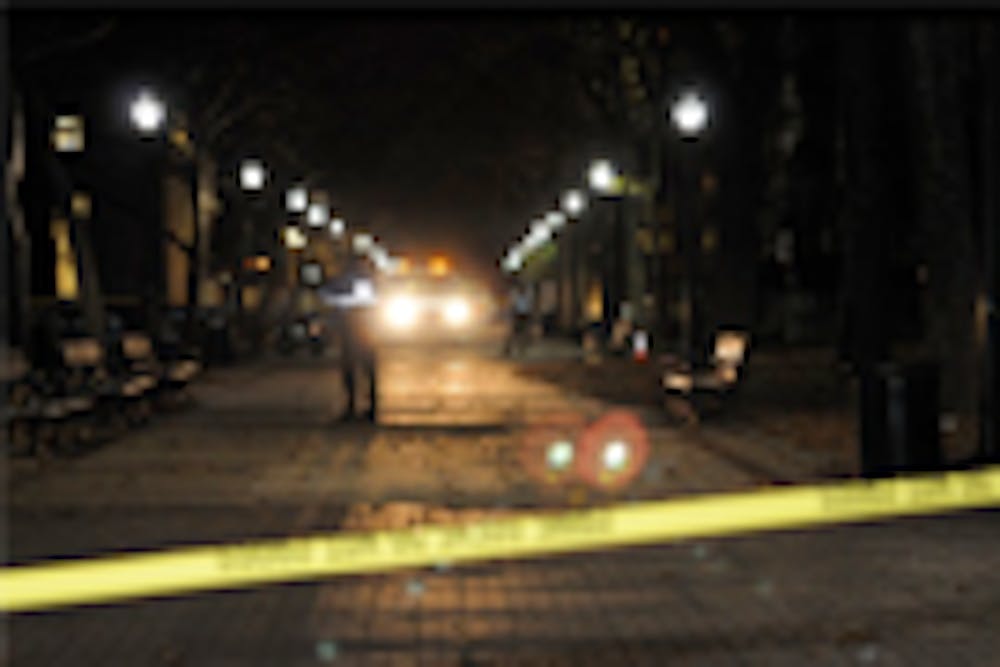
Photos from the scene at 40th and Locust streets in the early morning of Sunday, Nov. 21 after a shooting involving police and two suspects in a carjacking. Related article: Shots fired near high rises.
Though many in the Penn community raised concerns over the delayed UPennAlert e-mail notification and absence of a text message during Sunday’s shooting incident, Vice President for Public Safety Maureen Rush defended the Division of Public Safety’s decision not to use a text message, citing the immediate “neutralization of the threat” as reason to not raise undue alarm.
Executive Director of campus safety organization Security on Campus Jonathan Kassa explained that DPS’s decision to not use a text message alert is understandable after a threat has been contained. “You don’t want to cry wolf when the situation has already been taken care of,” he said.
Sunday’s shootout between police and two suspected carjackers left one suspect — 18-year-old Karl Sappleton, according to The Philadelphia Inquirer — dead. No other injuries were reported.
The second suspect, 18-year-old Leslie Mosby, was arrested on the 3900 block of Walnut Street. Mosby was charged Monday with attempted murder and carjacking and other crimes, according to the Inquirer.
According to Kassa, “text message fatigue” is a condition that many university police departments nationwide try to avoid. As campuses become more equipped with advanced technology, there is a need to ensure that the influx of notifications does not dilute the gravity of any one emergency system, Kassa explained. “University police departments want to ensure that when you get a text message, you know it’s serious.”
Despite the immediate containment of the threat, some Penn students maintain they would have preferred a text message alert. Acknowledging that “Penn Police had the situation under control,” Wharton freshman Jacob Dinkel said, “next time, I bet the police will be more apt to send a quick update saying ‘Situation under control, but stay away from 40th and Locust for next two hours.’”
Kassa attributed the Penn community’s response to DPS’s delayed communication to a “trust gap” between students and DPS. Kassa explained that in an information age, students may have different expectations of safety and communication than administrators.
In the case of Sunday’s incident, Kassa suggested, students were worried about their safety after hearing gunshots, while administrators who already knew that the situation had been contained felt no text message was needed.
Rush explained that in an emergency situation, UPennAlert notifications involve a balance between accuracy and speed of information dissemination. “Everyone wants speed, but we need to ensure that the information we’re sending is also correct.”
Monday, members of the Undergraduate Assembly met with DPS to discuss the future of emergency communication between DPS and the Penn community, focusing on the UPennAlert system.
“DPS was very understanding about the lack of text messaging,” UA Representative and Wharton senior Mo Shahin said. As a representative of the UA’s DPS Advisory Board, Shahin plans to communicate with Executive Vice President Craig Carnaroli and the Provost’s Office to develop a resolution regarding the policy on issuing a notification, specifically in expanding Rush’s authority in issuing an alert.
Currently, in the event of most emergencies, Rush would conference call with Penn’s crisis management team and consult with Carnaroli in order to send out a University-wide notification.
Rush explained that in an extreme situation, she would have the authority to instantly activate the Penn Siren Outdoor System, a public announcement system capable of broadcasting a message across campus.
The Daily Pennsylvanian is an independent, student-run newspaper. Please consider making a donation to support the coverage that shapes the University. Your generosity ensures a future of strong journalism at Penn.
DonatePlease note All comments are eligible for publication in The Daily Pennsylvanian.





